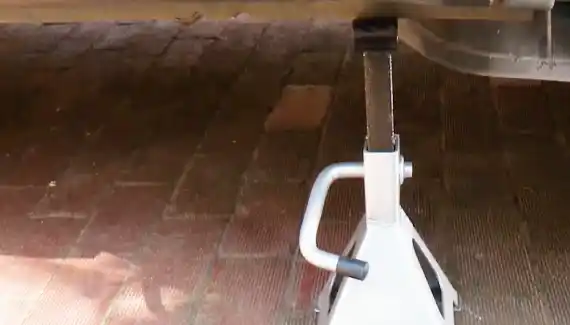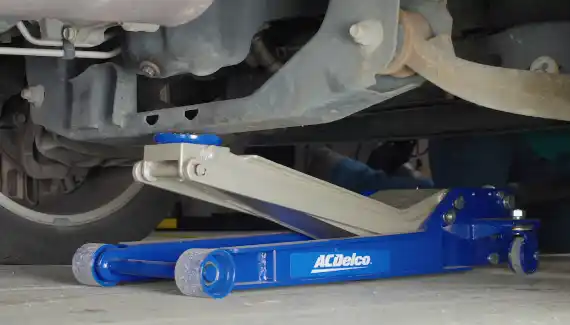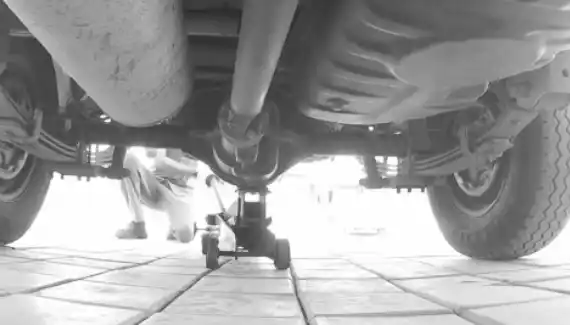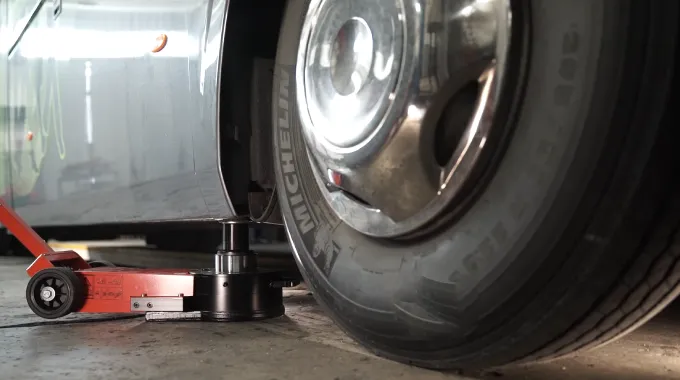Last Updated on July 9, 2023
Have you ever stopped to consider that a car jack could be used for more than just lifting small cars? Believe it or not, even hefty buses can change their tires using the same mechanic tool. With assistance from yourself or an experienced technician, tackling this task with a basic car jack is entirely achievable.
Replacing the tires on a bus is no easy feat and requires preparation, caution, and proper execution. All it takes is gathering the necessary tools, positioning the bus to get jacked up securely, raising it with your trusty car jack, and swapping out those old wheels for some fresh-from-the-box.
Let’s discuss the using procedure of a car jack, what precautions you should take, and what size jack you’ll need.
How Can Car Jack Lift a Bus To Change a Tire?

Mechanics must carefully lift the bus off the ground with a car jack to gain access and change out its tires. This critical step is key in ensuring that any new wheels are fitted securely.
Here are the steps to lifting a bus:
Step 1: Gather the Necessary Tools
To lift a bus with a car jack, the following tools and supplies are needed:
- A car jack that can lift more than 3 tons of weight.
- Jack stands (at least 2) to support the bus while it is lifted.
- Appropriate lug nuts and tires for the bus.
- Wrenches or other tools to remove and replace the wheels and tires.
- Blocks of wood or cement pads to help create a stable and level surface.
- Safety equipment, such as safety glasses, gloves, steel-toed boots, etc.
Step 2: Position the Bus for Jacking Up
The bus must be in a safe area with plenty of room for maneuvering around it before beginning any work on changing the tire. Once you’ve located an appropriate spot, use chocks or other means to block the bus’s wheels so that they won’t move while you are jacking up the bus.
Next, place cement pads or blocks of wood beneath each wheel to provide a stable surface for placing your jack stands. This will help prevent any shifting or slipping of your jack stand once they are put into place under your vehicle’s frame.
Step 3: Raise the Bus With the Jack
Raising the bus with a jack is an essential step in changing out its tires, as it ensures that there will be enough space between the ground and the wheels.
To begin, find an appropriate spot on your vehicle’s frame where you can place your car jack, usually behind or near the wheel, which needs changing. Then start pumping up your car jack until it has raised one side of the bus enough for jack stands (or ramps) to fit underneath securely.
Be sure not to lift too fast or too high, as this could damage your vehicle’s suspension system.
Step 4: Remove the Old Tires And Fit the New Tires

Once your bus is securely raised off the ground from jacking up, it’s time to remove its old tires and fit new ones. First, loosen all lug nuts from each wheel with a wrench until they are completely unscrewed from their mounting holes – but do not take them off completely yet.
Next, use a tire iron (or tire lever) to pry each tire off its rim before finally unthreading all lug nuts by hand. Once all these steps are complete, simply lay out your new tires on top of their respective rim before threading back on all lug nuts by hand and tightening them down with your wrench again.
Step 5: Slowly Lower Down the Jack
The final step in changing out tires on a bus involves slowly lowering your car jack once more. Ensuring that no damage has been done throughout the process. This should be done gradually over several minutes while ensuring that nothing shifts positions between wheels during descent.
Otherwise, this could cause serious injury (or worse). Once everything appears stable after lowering down fully, then you’re good to go.
Precautions Should be Taken Before Jacking Up a Bus
Jacking up a bus may sound straightforward, but there are many precautions that must be taken to do the job properly and safely. Here are some of the steps to take before jacking up any bus:
Choose an Appropriate Jack
There are several types of jacks on the market, each designed for different types of vehicles and loads. When selecting a jack for use on a bus, look for one rated to handle the weight of the vehicle you’re lifting. Ensure that the jack is in good condition and has no visible damage.
Inspect the chassis
Before you start jacking up your bus, check it thoroughly, including underneath, where you can see any rust or other damage that could make it unsafe to lift. Also, check all fluids and tires thoroughly before you start any work on them.
Chock Wheels During Work
Chocking wheels during work is an essential safety precaution when lifting heavy vehicles like a bus off its wheels. This prevents unexpected movement and keeps everything secure while work is done on it from underneath or above.
Never Stay Under The Bus
Never stay under a bus when it is lifted up with a car jack. Have someone else watch you while you work so they can tell if something falls down. They should move quickly if anything starts to fall unexpectedly while you work.
Check the ground
It’s essential that the ground underneath the bus is leveled and sturdy for you to start working on it safely. Be sure that no nearby objects like rocks, curbs, or other vehicles interfere with your workspace and cause obstruction while lifting.
Double Check Your Tools And Equipment
Before getting started with work on your vehicle, double-check all of your tools and equipment to ensure they’re in good condition and functioning properly. This will ensure better results as well as prevent accidents during use.
Which Car Jack Is Dependable For Lifting a Bus?

When it comes to elevating a bus, car jacks are the perfect tools for the job. Whether you opt for classic floor or bottle designs, they provide sufficient strength and stability to get your vehicle off the ground in no time.
With these reliable options on hand, lifting buses is simple. One quick pump of their handles will have them ready to support even large vehicles.
An air hydraulic jack is also another good option for lifting a bus as it offers greater power than the traditional mechanical floor jacks and has fewer parts that could potentially fail or malfunction. The air hydraulic jacks also tend to be lighter in weight than their mechanical counterparts, making them easier to transport.
To Lift a Bus, What Size Jack Is Appropriate?
The answer lies in its weight. If using a standard floor jack, then make sure to choose either 3 or 5 tons. A 5-ton hydraulic car jack will offer extra support and can handle heavier loads common with larger buses.
It is not a good idea to try and lift a bus with a trolley jack since it does not have enough strength. Instead, you should use two 20-ton bottle jacks, which are better for heavy lifting tasks. A bottle jack with a capacity of 30 or 50 tons should also be considered for extensive work, such as engine repairs.
How Tall of a Jack Do You Need For a Lifted Bus?
The size of jack required for a lifted bus really depends on how high it’s been lifted and the weight of the vehicle. If your bus has been lifted more than 4 inches, then it becomes necessary to have a jack that’s tall enough to elevate your bus.
Generally speaking, taller jacks are better because they provide more leverage and better stability. For most buses with medium-level lifts, between 4-8 inches, you’d want to look into 12-14 inches-tall jacks.
Of course, if you’re dealing with larger lifts, you’ll need an even taller jack. Sometimes, jacks up to 22 inches can be necessary.
Is It Possible to Damage a Car Jack By Lifting a Bus?

A car jack can sometimes be damaged by lifting a bus, although it’s not very common. This is due to the amount of weight that needs to be lifted to lift a bus. On average, a standard car jack can lift anywhere from around 3 tons and up, while a full-sized bus weighs much more than that.
If you think your vehicle is too heavy for the car jack, don’t risk putting excess strain on it. Try using specialized equipment instead. When it comes to buses, there may not be enough room underneath to use a car jack safely. Therefore special considerations and steps must be followed to perform any lift effectively.
Apart from this, a car jack is certainly one of the most trustworthy intent lifting tools for any vehicle, regardless of its weight.
Lift a Bus with the Strength of Car Jacks
Using a car jack can be an effective way of lifting up a bus to change its tires or conduct maintenance work. Before attempting this process, ensure all necessary safety precautions have been taken and the right type of car jack has been selected for the task at hand.
Aside from that, ensure that the size of your chosen car jack matches that of the bus so as not to damage any parts while attempting to lift it up. With these tips in mind, you’ll be able to safely use your car jack when lifting up your bus in no time.
